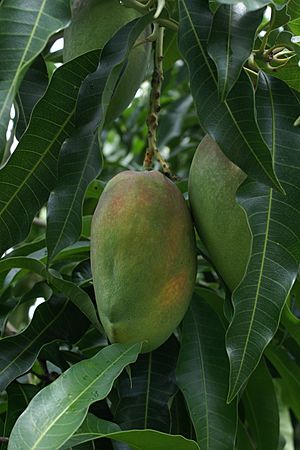Cogshall (mango) facts for kids
Quick facts for kids Mangifera 'Cogshall' |
|
|---|---|

Two 'Cogshall' mangoes pictured to the left and right with a 'Haden' mango in the middle, of which 'Cogshall' was likely a seedling
|
|
| Genus | Mangifera |
| Species | Mangifera indica |
| Hybrid parentage | 'Haden' seedling |
| Cultivar | 'Cogshall' |
| Origin | Florida, USA |

The Cogshall' mango is a special type of mango. It first grew in southwest Florida, USA. It is known for its tasty fruit and its small tree size. This makes it a great choice for home gardens!
The Story of the 'Cogshall' Mango
Where Did the 'Cogshall' Mango Come From?
The very first 'Cogshall' mango tree grew from a seed. This seed was planted on Pine Island, Florida. For many years, no one knew which mango tree was its parent.
How Scientists Found its Parent Tree
In 2005, scientists did a special study. They found that the 'Haden' mango was likely its parent. The first 'Cogshall' tree started growing fruit in the 1940s.
Testing the New Mango
In 1950, a young 'Cogshall' tree was planted. It went to the University of Florida's Tropical Research and Education Center (TREC). This center is in Homestead, Florida. More trees were planted there for testing.
In 1956, the fruit was shown to the Florida Mango Forum. People liked its good taste and color. It also resisted diseases well.
Why It Became Popular for Home Gardens
The 'Cogshall' mango did not become a big commercial mango. This was because its flesh was soft and its skin was thin. But later, experts like Dr. Richard Campbell recommended it. He worked at the Fairchild Tropical Botanic Garden.
The 'Cogshall' mango then became very popular. Many nurseries in Florida started selling it. People loved it because the tree stays small.
Where You Can Find 'Cogshall' Trees Today
You can find 'Cogshall' trees in special collections. The USDA has them in Miami, Florida. The Miami-Dade Fruit and Spice Park also has these trees.
What Makes the 'Cogshall' Mango Special?
The Fruit: Taste and Look
The 'Cogshall' mango fruit is shaped like an oval. It usually weighs a little less than one pound. When it is ripe, it has a yellow color. A bright red blush covers most of its skin.
The inside of the fruit is yellow. It is very juicy and sweet. It has no fibers, which means it's smooth to eat. It also has one large seed inside. In Florida, these mangoes are ready to eat from June to July.
The Tree: Size and Growth
The 'Cogshall' tree is known for its small size. Its branches grow closer together than other mango trees. This makes the tree naturally compact.
These trees can grow over 20 feet tall if left alone. But people often keep them under 10 feet. They do this by pruning (trimming) the tree regularly. Even at this smaller size, the tree still produces lots of fruit.
Some people call it a "dwarf" mango tree. It is a great choice for growing in large pots or containers.


